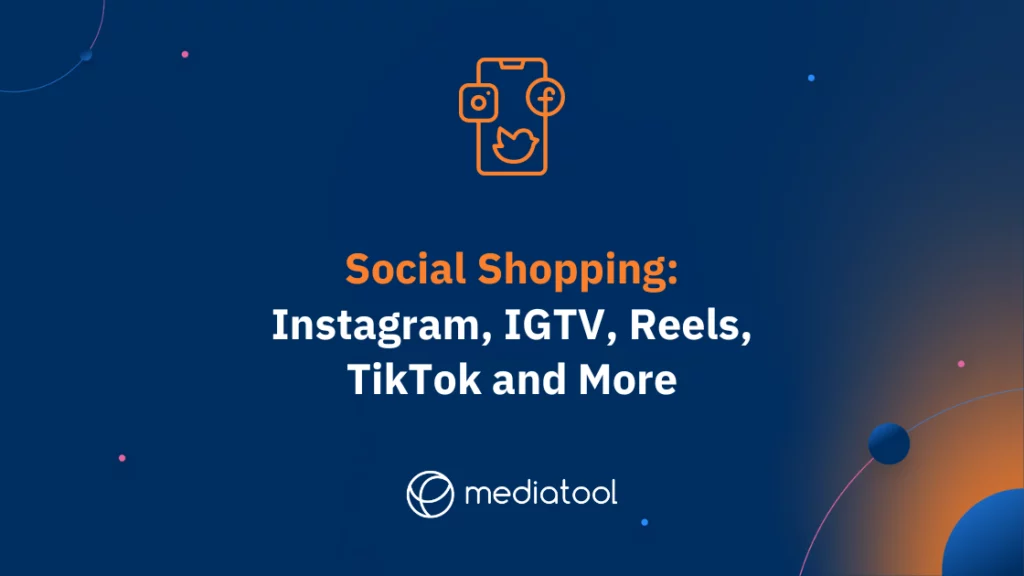Social shopping is bigger than ever.
When social media first came around its sole purpose was to help people connect and communicate with friends and family.
Nowadays, it’s developed into one of the most important ways for companies to connect, communicate and sell directly to their target audience.
Social media gives brands new opportunities to reach their customers and some brands now launch with their entire eCommerce model formed around social shopping.
What is Social Shopping?
Social shopping, an aspect of social commerce, is a phenomenon where consumers engage with products through social media platforms.
Unlike traditional online shopping experiences, social shopping features integrate seamlessly into social platforms, allowing users to view product photos, descriptions, and prices.
This approach simplifies the buying process, enabling purchases directly via the app or through links to the ecommerce site.
This method aligns with the dynamics of social media marketing, leveraging the power of influencer marketing and social proof.
For instance, brands on Instagram Shops can tag products in both their own and user-generated content, fostering product discovery and enhancing the online retail experience.
Social shopping tools on platforms like Facebook Messenger or Twitter Shops also contribute to this evolving social commerce market, offering new avenues for ecommerce businesses to reach potential customers.
Social shopping is distinct from other marketing strategies, as it shortens the purchase journey, often leading to impulse buying.
Statistics show that a significant portion of online purchases now result from interactions on social media networks.
The integration of social shopping features into these platforms, including augmented reality for product trials or live shopping events, is transforming how online retailers engage with their target audience, driving more sales and reshaping the social commerce landscape.
Why Use Social Shopping?
In 2022, worldwide sales via social media platforms were approximated at 992 billion U.S. dollars. The trend of making online purchases through these channels is expected to grow in popularity.
Projections indicate that by 2026, the worth of sales generated through social commerce could soar to approximately 2.9 trillion U.S. dollars.
Social shopping offers a multitude of benefits, making it a preferred choice for both consumers and ecommerce businesses.
On social media platforms like Instagram Shop and Facebook Shops, users can engage in a streamlined online shopping experience, directly interacting with products through specialized posts.
This approach differs from traditional social media marketing, focusing on an integrated buying process within the social media app.
The ease of social shopping features is a key draw.
With these tools, purchases can be made directly on the platform, simplifying the purchasing process. This is especially effective on mobile devices, where users often spend significant time.
Platforms like Facebook Messenger and Twitter Shops have leveraged these capabilities, enabling users to shop without leaving their favorite social media channels.
For ecommerce businesses, social shopping sites serve as a potent sales channel. Unlike other marketing strategies, social shopping taps into the vast user base of social media networks, presenting products to a wider, more engaged audience.
This not only boosts sales but also aids in product discovery, as potential customers encounter products through influencer marketing and social proof, often leading to impulse buys.
How to Use Social Shopping for Your Brand
Not every social media network offers social shopping and each one is different. So, here we break it down for you.
Instagram Shopping
Instagram, a leader in social commerce, offers comprehensive options for in-app purchasing. Notably, Instagram Checkout, available in regions including the U.S., allows users to complete transactions within the app using debit/credit cards and PayPal, enhancing the online shopping experience.
Setting Up Instagram Social Shopping Involves:
1. Creating an Instagram Business Account:
On your Instagram profile, tap the three lines in the top right, go to ‘Settings’ → ‘Account’, and select ‘Switch to Business Account’ at the bottom.
2. Undergoing Approval for Instagram Social Shopping:
Selling on social platforms like Facebook and Instagram requires passing an approval process, ensuring customer protection and maintaining the integrity of the social shopping site.
3. Integrating with a Facebook Profile:
Listing products on Instagram necessitates initial setup on Facebook Shop, which is then synchronized with Instagram Shopping via Facebook Business Manager.
4. Activating Social Shopping Features:
In your Instagram profile, tap the three lines, select ‘Settings’ → ‘Business’ → ‘Shopping’, choose a product catalogue, and click ‘Done’.
Utilization of Instagram Social Shopping:
Once approved with a product catalogue, you can engage in various forms of shoppable content:
Feed Posts: Tag products in your images, similar to tagging people. These shoppable posts appear on users’ personalized Explore pages, aiding in product discovery and reaching a broader audience.
Stories: Employ product stickers in Stories, a vital tool for businesses with smaller followings. This feature helps in selling products directly through Stories.
Live Streams (Available in the U.S. and other regions): Brands increasingly use live streams, particularly for product launches. This feature allows adding products to live streams, where viewers can add items to their cart in real-time, akin to a live shopping experience.
IGTV: Similar to feed posts, tag products in IGTV videos. Users need to click the ‘Browse’ button to view and purchase products.
Reels: Instagram’s newer feature, Reels, now includes shopping capabilities. Product tags in Reels prompt viewers with a ‘View Product’ option, enhancing the purchasing process.
Instagram Shopping, a key player in the social commerce market, offers a diverse range of social shopping tools, aligning with modern marketing strategies. It not only streamlines the purchasing process for social media users but also provides a significant sales channel for ecommerce businesses, boosting sales and expanding their social media presence.
Facebook Shops
Facebook Shops, a key ecommerce feature within Facebook’s platform, is pivotal in advancing social shopping, much like its counterpart, Instagram Shopping. Owned by Meta, both platforms exhibit similar functionalities, emphasizing their role in the burgeoning social commerce market.
Setting Up Facebook Shops:
Getting started with Facebook Shops is straightforward, provided you have a Facebook Page for selling and a business account. The setup involves updating your product catalog and customizing your Facebook shop, aligning with your brand’s aesthetic.
Requirements and Market Support:
To utilize Facebook Shops, adherence to Facebook’s commerce eligibility criteria is necessary. The platform supports a wide range of global markets, with a comprehensive list available for reference.
Maximizing the Facebook Shopping Experience:
Utilizing Facebook Commerce Manager is essential for optimizing your social shopping strategy. This tool offers various features to enhance your online store’s performance:
Collections: Organize your products into collections for easier customer navigation.
Advertising: Implement Custom Audiences in ad campaigns to target interested shoppers.
Insights: Commerce Manager provides valuable insights into your shop’s performance, aiding in the optimization of your ecommerce offerings.
Exposure: Your products can be featured in popular shopping areas on Facebook, like Marketplace.
Cross-Platform Direct Messages: Facebook Shops can interact with customers through Messenger, Instagram Direct, and, in the future, WhatsApp, offering versatile communication channels.
In addition to these features, businesses can leverage Mediatool’s Facebook and Instagram integrations for real-time campaign tracking and measurement. This integration not only enriches the online shopping experience for social media users but also enables ecommerce businesses to effectively target potential customers and enhance their social media presence.
Facebook Shops, as a social commerce platform, offers diverse retail channels and innovative marketing strategies. Its integration into Facebook and other social media channels is transforming the ecommerce landscape, presenting unique opportunities for businesses to boost sales and connect with a broader audience.
TikTok
TikTok has made significant strides in social commerce, integrating ecommerce capabilities directly into its platform. With the #TikTokMadeMeBuyIt hashtag amassing over 80 billion views, TikTok has become an essential component of online retail strategies, particularly for reaching a Gen Z target audience. In 2020, TikTok achieved a record 33 million downloads in a single quarter, demonstrating its expansive reach among social media users.
Setting Up TikTok Shopping:
To establish a TikTok Shop, businesses must first meet the app’s requirements. The setup process includes:
- Downloading the TikTok App: Available in the Shopify App Store for seamless integration.
- Creating a TikTok for Business Account: This includes connecting your payments to Shopify within the TikTok app.
- Implementing TikTok Pixel: Similar to the Facebook Pixel, this code is added to your Shopify website, providing valuable performance analytics.
Features of TikTok Shopping:
Shopify Integrated Advertising: Shopify merchants can create shoppable ads directly from the Shopify Dashboard.
Video Ads: Businesses can craft shoppable video ads that appear on the TikTok For You Page, enhancing product discovery and purchasing directly through the app.
TikTok Shopping API: An upcoming feature that promises to expand TikTok’s social shopping capabilities.
Third-Party Partner Integration: This includes platforms like Shopify, Square, Ecwid, and PrestaShop, allowing for a broader ecommerce presence.
Product Linking in Videos: Businesses can include product links in their TikTok videos, further engaging with potential customers.
TikTok’s partnership with Shopify marked a significant move towards social shopping on the network. This collaboration enabled brands to sell products using shoppable video ads, blending influencer marketing with direct selling strategies.
The emergence of TikTok in the social commerce market highlights its role as a powerful sales channel for online retailers. As a social media platform with a unique algorithm that prioritizes content quality over follower count, TikTok offers a distinct online shopping experience, setting itself apart from other social media platforms and becoming a favorite platform for social shoppers and ecommerce businesses alike.
What’s Next for Social Shopping?
Future Trends in Social Shopping
As we move forward from the significant developments in social shopping that emerged in 2020, the landscape continues to evolve rapidly. As of my last update in April 2023, we’ve seen continuous innovation in this domain. Looking ahead, there are several potential trends and advancements to anticipate:
Anticipated Developments in Social Shopping:
Expansion of In-App Shopping Experiences:
Following the leads of Facebook and Instagram, other platforms like TikTok are likely to enhance their in-app shopping experiences. This could include more integrated and seamless purchase processes directly within these apps.
Broader Platform Participation:
Platforms traditionally not associated with ecommerce, such as LinkedIn, may explore options for allowing users to purchase services or products directly through their apps, tapping into a more professional market segment.
Increased Importance for Marketers:
The ongoing growth in social shopping means that marketers must juggle more responsibilities, from content planning to result measurement. This necessitates more sophisticated tools and strategies to effectively manage and optimize social media shopping campaigns.
Advanced Analytical Tools:
Tools such as Mediatool will become increasingly crucial, offering marketers the ability to plan campaigns more efficiently and access real-time results. This helps in determining the most effective strategies for social media shopping campaigns.
Personalization and AI:
Enhanced use of artificial intelligence (AI) to personalize the shopping experience is expected. AI can offer tailored recommendations and a more intuitive shopping journey based on user behavior and preferences.
Augmented Reality (AR) Integration:
AR could play a larger role in social shopping, allowing users to virtually try products before purchase, thereby enhancing user engagement and potentially increasing conversion rates.
Social Commerce and Sustainability:
A growing trend towards sustainability in social shopping might emerge, with platforms and brands focusing more on eco-friendly products and practices.
Community-Driven Commerce:
We might see a rise in community-driven commerce, where purchases are influenced by social groups, communities, and peer recommendations on social platforms.
As social shopping continues to grow, brands seeking to improve their presence in this space should consider these future trends. For those looking to refine their social shopping strategies, exploring tools like Mediatool could provide valuable insights and clarity in navigating the evolving landscape of social commerce.





